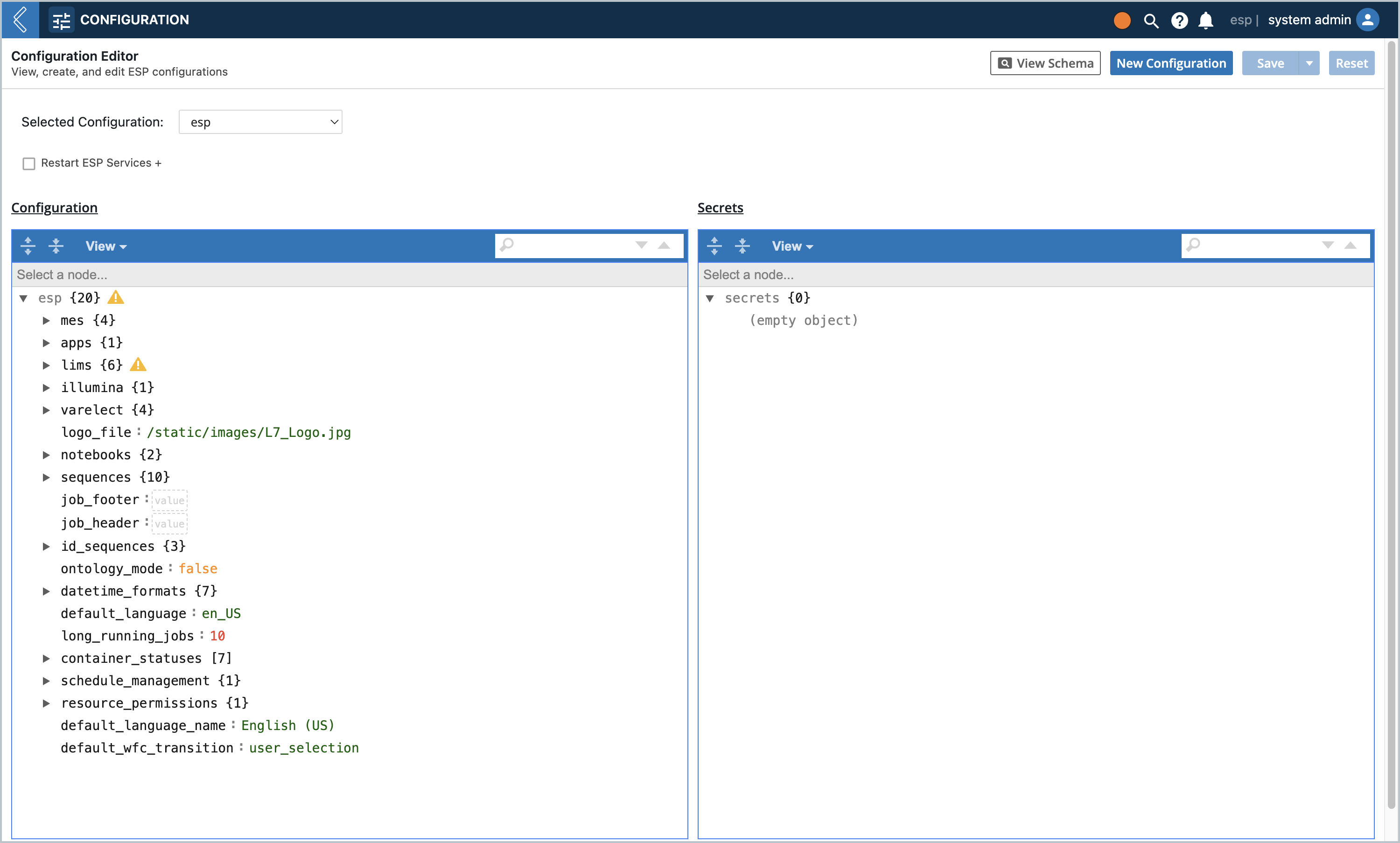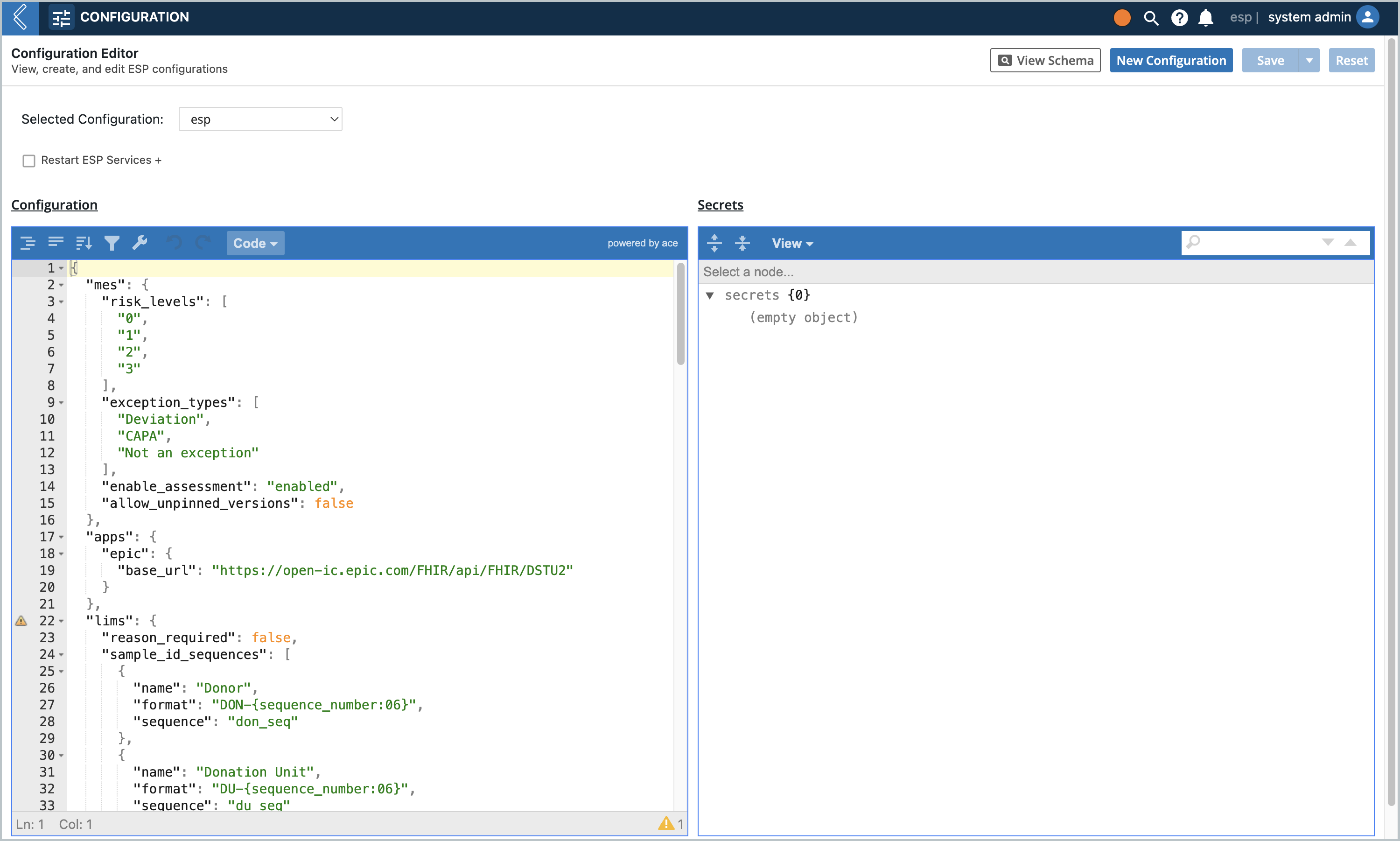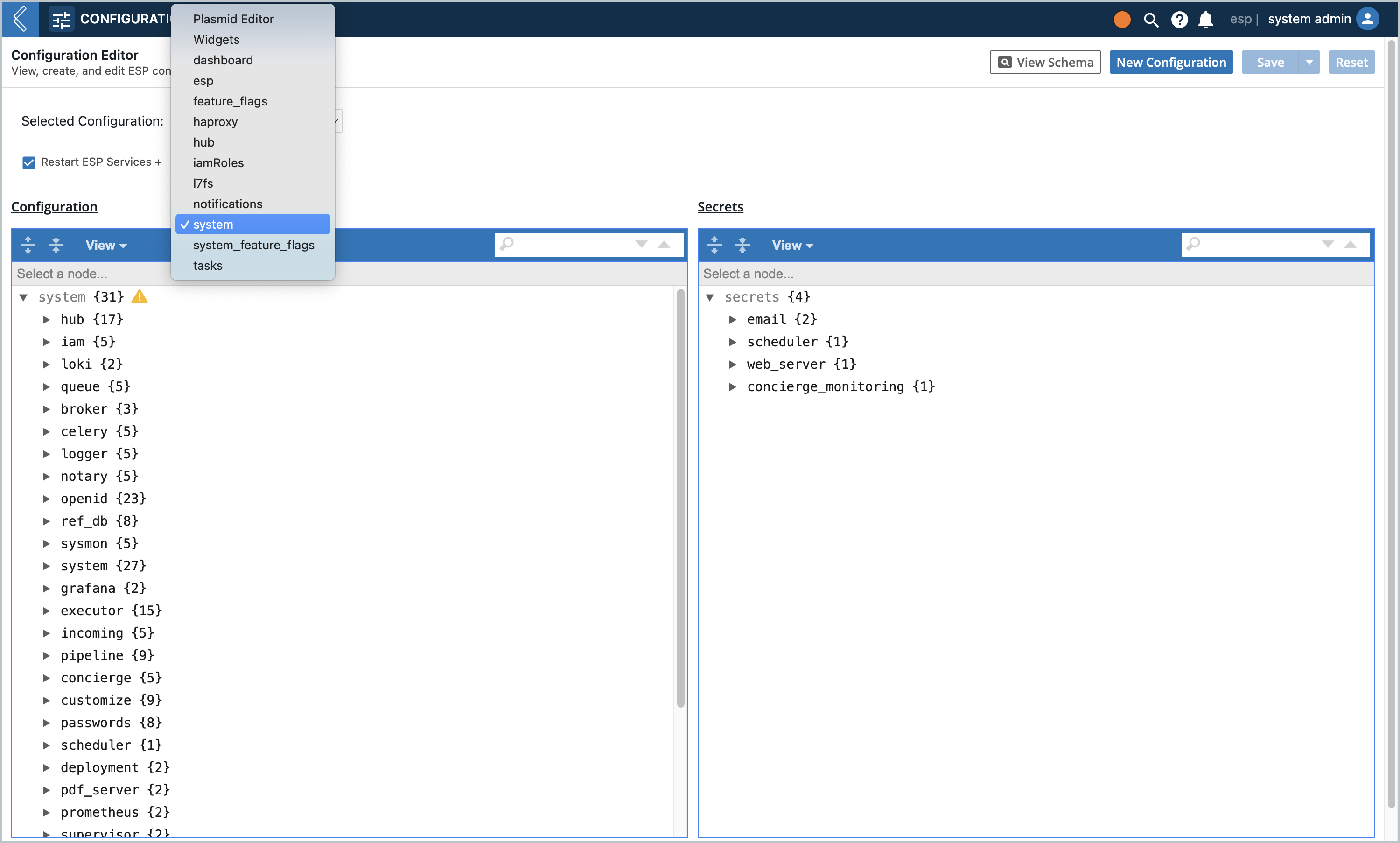L7 Configuration
What is it?
The L7 Configuration app is used to manage L7|ESP configuration data and create arbitrary configurations (key-value definitions) for custom content.
How do life sciences teams use it?
The L7 Configuration app is comprised of pre-seeded configuration files as well as user defined configurations. A lab might use the "esp" configuration to assign unique ID Sequences to their entity types, experiments, and notebook entries. Several user defined configurations were also created to store static values used in pipelines and invokables.
Watch: 2-Minute Tour
Screen shots
View and manage configuration files

Edit configuration files from Code view using JSON

Navigate between configuration files

esp Configuration
Note
If you do not see an item you are looking for, contact university@l7informatics.com
Configuration | Description |
|---|---|
mes → risk_levels | Risk levels for exception assessments during quality review. |
mes → exception_types | Exception types for exception assessments during quality review. |
mes → allow_self_review | Allow users who entered data, signed, or changed data in the EBR to participate in quality review as an operations or quality reviewer. |
mes → enable_assessment | Globally enable exception assessment during quality review. Note: users need additional permissions to make assessments with this feature enabled. |
mes → allow_unpinned_versions | Allow users to use unpinned Recipes when creating new Batch Records in L7 MES. |
lims → reason_required | Require the user to enter a reason when making changes to completed samples in a LIMS worksheet. |
lims → field_spec_types | Spec types for numeric fields in L7 MES. |
lims → sample_id_sequences | ID sequences for Entity Types in L7|MASTER. Note: this is a legacy configuration that pre-dates id_sequences → entity. |
lims → auto_sample_id_format | Default ID sequence assigned to newly created Entity Types in L7|MASTER. |
lims → full_sheet_evaluation | Evaluate expressions for downstream Protocols in a LIMS worksheet. By default, expressions are evaluated for active samples in the current Protocol. |
lims → user_credentials_required_on_edit_complete_rows | Require the user to enter their L7|ESP username and password when making changes to completed samples in a LIMS worksheet. |
illumina → adapter_datasource | Specifies the legacy datasource that defines Illumina adapters. For modern Illumina support, see the Illumina Hub Bundle. |
varelect | Legacy support for VarElect. |
logo_file | Global logo used in the header of L7 MES reports. |
notebooks → autosave | Enable autosave and the time interval between saves for Notebook Entries. This time interval, measured in seconds, is also used to group Notebook Entry versions. |
notebooks → other_user_approval | Allow users not logged in to sign Notebook Entries. |
notebooks → entry_name_templates | Auto-assign names to Notebook Entries. |
notebooks → entry_restore_enabled | Restore archived Notebook Entries. |
notebooks → no_of_versions_in_group | Number of Notebook Entry versions grouped under Version History. |
notebooks → worksheet_save_wait_timeout_seconds | Time to wait for a Notebook Entry to save. |
notebooks → time_interval_for_grouping_versions_minutes | Time between saves used to group Notebook Entry versions if autosave is disabled. This value cannot be less than 30 minutes. |
passwords → user_change_ok | Determines whether a user can change their own L7|ESP password. Valid values:
|
sequences | The database name of all ID sequences and the |
job_footer | Common footer (string) added to all Tasks at runtime. |
job_header | Common header (string) added to all Tasks at runtime. |
id_sequences → item | ID sequences for Item Types in L7|MASTER. Note: ID sequences can only be assigned to Items created in Sample Protocols, not L7 Inventory. |
id_sequences → entity | ID sequences for Entity Types in L7|MASTER. |
id_sequences → experiment | ID sequences for Workflows in L7|MASTER used to name Experiments in L7 Projects. |
ontology_mode | Require Entity and Protocol fields to adhere to an ontology, specified in a JSON file. |
datetime → date | Default date format. |
datetime → time | Default time format. |
datetime → datetime | Default datetime format. |
datetime → extended | Default datetime format for extended requests. |
datetime → extended-utc | Extended datetime format for UTC requests. |
datetime → extended-local | Extended datetime format for local requests. |
default_language | Default language code for L7|ESP. |
container_statuses | Legacy configuration for Container statuses. In L7|ESP 3.5 this has moved to the |
schedule_management → task_types | Name and color of task types in L7 Scheduling. |
resource_permissions → enabled | Allow more than one (1) user to work on the same Notebook Entry. |
default_language_name | Default language name for L7|ESP. |
default_wfc_transition | Default transition strategy for Workflow Chain transitions in L7|MASTER. |
feature_flags Configuration
Flag Path: The configuration path for the flag. For instance, the path for mes.preview_mode is:
{
"mes": {
"preview_mode": "value"
}
}Note
If you do not see an item you are looking for, contact university@l7informatics.com
Flag Path | Flag Description | Recommended Setting |
|---|---|---|
mes.preview_mode | Enables the ability to render an MES MBR “preview” (PDF) within L7|MASTER → workflow chain builder. | Enabled for MES customers, disabled for others. |
mes.template_type_restrictions | Enables ESP to enforced additional restrictions on protocols, workflows, and workflow chains, such as locking the “use in manufacturing” value after creation. | Customer preference. |
i18n.status | Enables i18n support (also requires an i18n app-enabled license key for full support). | Disabled unless i18n is required. |
lims.card_view | Enables “card view” in the LIMS landing page. | Disabled (card view currently has some issues when there are many worksheets). |
lims.auto_height | Enables “auto height” in LIMS grid views, where the height of each LIMS grid row is determined dynamically by the contents of each cell in the grid. | Disabled unless auto-height is absolutely necessary. Auto-height carries rendering performance penalties because the grid has to recalculate the height of every row when data changes. |
lims.data_caching | Enables “data caching” in LIMS. Data caching guards against accidental data loss by “caching” unsaved changes and allowing the user to reapply these changes when the sheet is re-opened later. | Customer preference. |
lims.container_layouts | Enables the experimental “container layouts” feature. This feature allows users in LIMS to create now “layout templates” for containers (like plates) that can be reapplied to new experiments at a later date. The feature should be considered beta status. | Customer preference. L7 appreciates feedback on this in-development feature. |
lims.expression_timing | Enables expression timing. Expression timing is useful for performance optimization of data saves for complex workflows. Enabling it incurs a small amount of additional overhead during the save. | Enable during development and testing. Disable for production execution, unless needed to troubleshoot a production issue. |
lims.worksheet_locking | Enables worksheet locking. With worksheet locking enable, when a user begins to edit values in a LIMS worksheet, they take control of it and other users may view but not edit the worksheet until the lock is released (usually automatically by the action of saving the sheet). | Enabled. |
lims.backlog_smart_cards | Enables “smart cards” in the LIMS backlog. When smart cards are disabled, the information in each sample card is adjusted based on the current grouping to avoid redundant information. It makes the backlog display a little more concise. | Disabled. In L7’s experience, it hasn’t added much value and L7 is currently considering removing this feature flag and capability unless we receive customer feedback to the contrary. |
lims.other_user_approval | Enables the ability for a non-signed-in-user to sign a signature flow or other type of approval by entering a username and password. | Disabled. For most organizations and security requirements, it’s best to have the user sign in prior to signing an approval. |
lims.dynamic_header_height | Enables auto-adjusting the height of the header row of LIMS tables based on the header contents. | Disabled unless critical. Enabling this flag incurs a UI-performance penalty. |
lims.container_editor_days_limit | When using a container editor in LIMS, there’s a dropdown that populates with existing containers of the appropriate type. Normally, this dropdown populates with all containers of that type, but this flag allows restricting the list to those created within the last N days (where N=0 means “only those containers created today”). | Depends on the use-case, but generally best to set it to some value other than disabled to ensure the container editor performance stays stable over time. |
lims.no_matching_rows_skips_action | Prior to ESP 3.5, if a protocol action had > 1 condition and each condition matched a subset of rows, the action would fire even if the matching subset of rows were disjoint. With this flag enabled, the action will only fire if the intersect of the rows matched by each condition is non-empty. | Enabled. |
lims.early_onchange_evaluation_on_approval | When using approval fields (not signature-flow based), improves change handler support for these fields by firing them before the approval payload is sent to the server and allowing the change handler to abort the send action. This improves backwards compatibility somewhat with workflows created pre ESP 3.3. | Disabled. Instead, use signature flows which already implement the most common reasons customers were using change handlers for approvals anyway and have much more flexibility and capability in general. |
lims.failed_sample_prevents_grouped_pipeline_execution | When enabled, users will be unable to launch a pipeline for a grouped pipeline protocol or grouped protocol with a pipeline button if any samples in the group have been aborted. | Customer preference, but usually disabled. |
uuid7.status | When enabled, turns on UUID7 support This was a flag originally because UUID7 was provisional, but has since been accepted into the UUID standard. | Enabled. uuid7 significantly improves batched record insert performance on large ESP instances. |
assets.equipment.launchable_workflows | Enables equipment maintenance schedules to associate a workflow with the maintenance. | Customer preference. |
entity.linked_items_tab | Enables the “Linked Items” tab in the details view for a an entity (samples, etc.). This tab shows notebook entries that reference the object using the | Enabled for Notebook customers. |
ingest.show_instance_status_and_logs | Enables additional status and logging information disable in the ingest app for ingest instances. Useful for debugging failing ingests. | Enabled. The logs are collected regardless, so enabling will provide easier access to them and can contain valuable timing data for long-running ingests. |
master.equipment.custom_views | Enables creating and viewing a custom equipment detail tab. | Customer preference. |
master.workflows.experiment_launcher | Enables a “Launch LIMS Experiment” button in the L7|MASTER workflow builder that streamlines creating new experiments and LIMS worksheets for workflow testing purposes. | Enabled for development. |
master.containers.custom_views | Enables creating and viewing a custom container detail tab, including for Kits. | Customer preference. |
planner.status | Enables the “Planner” tab in the projects app. | Disabled. The planner tab has known performance issues and has been deprecated in favor of the Scheduling app. |
docusign.status | Enable “docusign” (or other 3rd party digital signing, such as adobe sign) support. | Enable if integrating with docusign or adobe sign. |
projects.experiments.groupby_tabs.by_owner | Enables the “By Owner” tab of the Experiments view in the Projects app. | Disabled for large installations. |
projects.experiments.groupby_tabs.by_project | Enables the “By Owner” tab of the Experiments view in the Projects app. | Disabled for large installations. |
projects.experiments.groupby_tabs.by_workflow | Enables the “By Owner” tab of the Experiments view in the Projects app. | Disabled for large installations. |
projects.experiments.allow_create_worksheet_with_submit | Enables users to create a LIMS worksheet with the same name as their experiment, containing all experiment samples, when they submit samples. | Customer preference. |
container.tree_view | Enables the “Tree view” in the locations app. | Disabled for large installs on ESP < 3.5. This flag is not relevant in 3.5 since the Locations app was merged into the new Assets app. |
designers.implementor_designer | Enables the experimental “Implementor Designer' builder in LIMS, which can map from an input excel file in a certain format directly to ESP objects. | Customer need-dependent. L7 appreciates feedback on this beta feature. |
flex_view.print_button | Enables the “Print” button for flex views. | Customer need-dependent. For implementations that do not need to print flex views, L7 recommends disabling this capability to avoid user confusion. |
locations.platemap.show_item_names | Enables the name of the item occupying a “plate well” in plate-style containers (including all containers within LIMS container editor). | Enabled. |
locations.platemap.enforce_unique_objects | Enables enforcing the rule that an object cannot be placed in more than one “slot” in the same container. This flag only enables enforcement at the UI level. The enforcement is only within a container and does not prevent distributing an entity across multiple different containers. | Customer preference. |
notebooks.rich_text_table | Whether the Rich Text editor widget in notebooks includes a “Table” button. | Disabled. L7 recommends using the table widget or the spreadsheet widget instead. These produce JSON structures of the data that simplify downstream processing of ELN data, where the table button in the rich text editor widget produces an HTML table directly. |
notebooks.live_collaboration | Enables “live collaboration” where two users can edit the same notebook at the same time as long as they are editing different widgets within the notebook. | Disabled, especially in 3.5 due to conflicts with version history capabilities introduced in 3.5. |
logStreaming.status | Enables log streaming to the UI. Experimental feature. | Disabled. Contact L7 support to discuss enabling. |
knowledge_graph.status | Enables the OOB knowledge graph capability. | Disabled. Contact L7 support for access to the knowledge graph HUB bundle, instead. |
entity_data_view.table_grouping | Enables the “grouped data” view in the entities app. When this flag is disabled (the default), each custom field “group” is represented as a nested tab in the “Data” tab of the entity details view. When the flag is enabled, all custom fields are displayed in a single table, grouped by custom field group. | Customer preference. The disabled state is tested more extensively but L7 appreciates feedback on whether the “enabled” state provides a better user experience overall. |
lims_document_view.status | Enables the “document view” capability in LIMS, which provides a view in LIMS analogous to the EBR tab in MES. | Disabled. Doc View in LIMS is highly experimental and only really useful for single-sample workflows. |
dynamic_expressions.status | Enables the “Dynamic Expressions” experimental capability in LIMS. This capability allows some cell expressions to be calculated real-time in the browser, avoiding the need for a save to compute the result. This can reduce implementation times by reducing the number of “change handlers” required for real-time calculation support. | Disabled. The feature works, but after some field testing, L7 believes some additional refinements are required for a better overall experience. However, feedback from customers on this capability is appreciated. |
job_progress_monitor.status | Enables the “job progress” monitor support. | Customer preference. Enabling provides more insight into LIMS save progress, among other things. |
n_dimensional_vectors.status | Enables “Vector Field” support. In ESP 3.3 and 3.4, this enables support for both MES and LIMS. In ESP 3.5, this enables support in LIMS because support in MES (or protocols marked as “Use for Manufacturing” = “Yes”) is always enabled. | Customer preference. L7 appreciates feedback on this capability in LIMS. |
chart_widget_regression_analysis.status | Enables the ability to add regression lines to charts in the Notebooks app. | Disabled. |
editable_generic_renderer_widget.status | When enabled, the code in Generic renderer widgets in flex views can be directly edited within a LIMS worksheet. This can accelerate development time for custom flex view displays by allowing real-time edit-render cycles without having to create new experiments for each edit. However, the edited widget code is NOT saved anywhere, so developers must copy any desired changes back to the Protocol in L7|MASTER. | Enabled for development environments, disabled for production. |